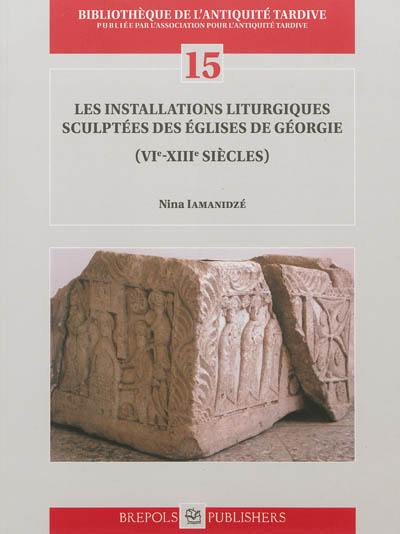
Fiche technique
Format : Broché
Nb de pages : 303 pages
Poids : 400 g
Dimensions : 22cm X 28cm
ISBN : 978-2-503-53408-4
EAN : 9782503534084
Les installations liturgiques sculptées des églises de Géorgie
VIe-XIIIe siècles
Quatrième de couverture
Convertie au christianisme au début du IV siècle, la Géorgie ancienne a laissé beaucoup de monuments remarquables. Néanmoins, malgré sa qualité et sa richesse exceptionnelle, une bonne partie de l'art chrétien géorgien est longtemps demeurée méconnue. En particulier, si les peinture murales et l'architecture des églises on attiré l'attention des chercheurs, les aménagements et dispositifs liturgiques sont restés longtemps inexplorés. Pourtant, il s'agit d'une composante majeure du patrimoine géorgien médiéval, et on a là des témoignages archéologiques fort importants pour cerner non seulement la tradition artistique, mais aussi les rites et le coutumes de l'Orient chrétien.
L'ouvrage traite des éléments sculptés à destination culturelle, qui constituent un groupe au décor extrêmement riche, avec un série d'images inspirées par l'Ancien et le Nouveau Testament, souvent réunies dans des programmes iconographiques amples et accomplis. Les limites chronologiques (VIE-XIIIe s.) correspondent très exactement à la période de l'apparition et du développement de ces images sculptées sur les installations liturgiques en Géorgie.
L'étude montre l'intérêt particulier du contexte des objets, en visant à mettre en évidence les rapports entre la nature des pièces, la thématique qui s'y développe et leur fonction culturelle. Mais c'est surtout une première tentative pour jeter une lumière sur l'organisation de l'espace dans les églises géorgiennes, sur le rôle des aménagements cultuels, et contribuer ainsi à la connaissance des usages liturgiques dans les confins du monde byzantin.
L'attention est portée d'une part aux problèmes liés à la production de ces monuments et à la répartition géographique des ateliers. Un autre aspect, qui relève d'une problématique plus vaste, concerne l'adaptation et l'interprétation des modèles byzantins en Géorgie. On a, par ailleurs, reproduit et traduit les nombreuses inscriptions qui permettent d'observer différentes attitudes dans la référence aux textes sacrés, leur rôle et fonction ; mais cela amène aussi à envisager la tradition de représentation des donateurs, qui révèle les usages dévotionnels et, dans certains cas, renvoie à la perception du sacrement eucharistique.
Par le biais de comparaisons avec ce qui se trouve attesté dans les autres entités culturelles de l'Orient chrétien (et des régions plus éloignées), l'ouvrage apporte un éclairage nouveau sur la vie spirituelle et l'histoire religieuse du pays, et sur ses relations culturelles avec le reste du monde chrétien : à côté des traditions locales, on constate ainsi l'existence de liens étroits entre la Géorgie et les contrées voisines mais aussi, parfois, avec l'Occident.
Liturgical installations made from store represent a considerable part of Georgian artistic heritage, constituting archaeological evidence important for the definition net only of artistic tradition, but also of the rites and the practices of the Christian East. The high quality of surviving items makes their research particularly important. However this material remains largely unknown; it bas never received the attention that, for example, Georgian wall painting and metalwork bas received, although it is equally significant.
This book studies a variety of sculpted religions objects in cultic use in Georgia. The chronological limits (6th-13th c.) correspond to the period of the emergence and development of figural decoration on liturgical installations in this arec. The sculptural iniagery of these pieces, extremely rich and unique in medieval art, is undoubtedly a privileged field for iconography : they present the whole gallery of scenes from the Old and New Testaments, often unified in well-developed and accomplished iconographie programmes.
The research shows particular interest in questions about the contexts of objects, and focuses on problems of fonction and the relationship between the iconography of Bach piece and the liturgy. Thus, it attempts to shed new light on the organization of space in Georgian churches and to contribute to the knowledge of liturgical practice on the borders of Byzantium.
Attention is paid to the problems related to the production of these pieces and to the geographical distribution of the workshops. Another aspect, which reveals a larger problematic, is the adaptation and the interpretation of the Byzantine models in Georgia. The study reproduces and translates a number of inscriptions permitting observation of the various approaches to the use of the sacred texts, their role and function ; but it also helps to identify the tradition of representation of the donors on the liturgical installations, revealing devotional use of objects and referring to the prayers of intercession in the liturgy or, in certain instances, directly to the Eucharistie sacrament.
Through interactions of artistic traditions and liturgical practices, this study brings new light to the spiritual lite and the religious history of Late Antique and Medieval Georgia and its cultural relations with the other areas of the Christian world, reflecting, beside the local traditions, the close links between that country and neighboring areas but also, in some cases, the distant West.





